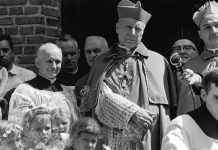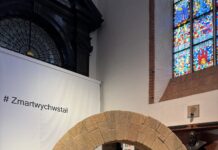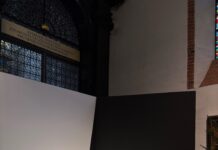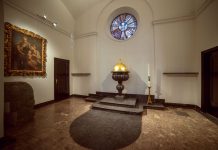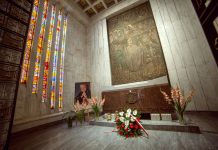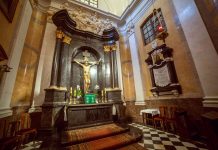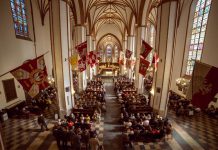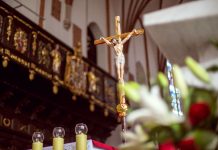Kaplica składa się z portalu (XVII w., rekonstrukcja) i wnętrza, które jest dziełem artysty plastyka Zbigniewa Łoskota (1922 – 1997).
W ścianie na prawo od wejścia znajduje się sarkofag ze szczątkami kardynała Augusta Hlonda, Prymasa Polski. Przeniesiono je tutaj z podziemi archikatedry 9 marca 2006 roku.
Wyryto na nim słowa: Da mihi animas, caetera tolle – Daj mi dusze, resztę zabierz – będące dewizą biskupią Prymasa. Nad sarkofagiem znajduje się, wykonana z brązu w 1960 roku, płaskorzeźba kardynała Augusta Hlonda – dłuta prof. Zofii Trzcińskiej – Kamińskiej (1870 – 1977). W kaplicy znajduje się też obraz Michaela Willmanna.
Wnętrze kaplicy składa się z ozdobionej ceramiczną mozaiką kopuły z latarnią oraz z trzech łukowatych ścian oddzielonych od kopuły gzymsem. Na ścianie ołtarzowej nad marmurową płytą ołtarza umieszczona jest kompozycja z płyt ceramicznych przedstawiająca postać św. Jana Chrzciciela w otoczeniu grup proroków Starego Testamentu. Św. Jan Chrzciciel wskazuje palcem na Baranka Bożego umieszczonego na złotej patenie otoczonej kołem promieni z mozaiki. Wszystkie trzy ściany są pokryte płytami z kolorowego i gładzonego tynku (fresk florencki).
Całość kompozycji ołtarzowej kaplicy ma ukazać dramat człowieka, który przez grzech zdradzając Boga i odchodząc od Niego nie może liczyć na żadne ludzkie możliwości zbawienia, a jedynie na Jezusa – Zbawiciela, złożonego w ofierze na drzewie Krzyża.
Św. Jan świadkiem i ostatnim prorokiem zapowiadającym Mesjasza. Dlatego otaczają go dwie grupy proroczych postaci Starego Testamentu.
Oto podstawy biblijnej treści kompozycji:
Ewangelie przedstawiają św. Jana jako człowieka gwałtownego i surowego: Plemię żmijowe, kto wam pokazał, jak uciec przed nadchodzącym gniewem? Wydajcie więc owoce godne nawrócenia (Łk 3,7-8) bezkompromisowego, który dał życie za prawdę, ascetę, nawołującego nieraz bezskutecznie do pokuty: Nawróćcie się, bo bliskie jest królestwo niebieskie (Mt 3, 1).
Jezus mówił tłumom o Janie: Coście wyszli oglądać na pustyni? Trzcinę kołyszącą się na wietrze? Po coście więc wyszli? Proroka zobaczyć? Tak, powiadam wam, nawet więcej niż proroka. On jest tym, o którym napisano: Oto Ja posyłam mego wysłańca przed Tobą, aby Ci przygotował drogę. A jeśli chcecie przyjąć, to on jest Eliaszem, który ma przyjść. Kto ma uszy, niechaj słucha! (Mt 11, 7 – 15)
Słowa św. Jana Chrzciciela wskazującego na Chrystusa:
Oto Baranek Boży, który gładzi grzech świata. Ja Go przedtem nie znałem, ale Ten, który mnie posłał, abym chrzcił wodą, powiedział do mnie: „Ten, nad którym ujrzysz Ducha zstępującego i spoczywającego nad Nim, jest Tym, który chrzci Duchem Świętym”. Ja to ujrzałem i daję świadectwo, że On jest Synem Bożym.
(J 1, 29 – 34)
Po stronie lewej od wejścia stoją:
Patriarcha Abraham – ofiarujący Izaaka, patrzy w górę, na Baranka;
Patriarcha Mojżesz trzymający dwie tablice z przykazaniami;
Prorok Samuel – trzymający dwa naczynia z oliwą, którą namaścił pierwszych królów Izraela – Saula i Dawida;
Król Dawid – Psalmista i Prorok, przedstawiony z harfą;
Prorok Eliasz – największy z Proroków, walczący o czystość wiary, trzyma chleb, którym Bóg cudownie karmił go w czasie suszy.
Po stronie prawej od wejścia stoją:
Prorok Izajasz – z gwiazdą i lilią nad głową, prorokuje o Najświętszej Maryi Pannie: Oto Panna pocznie i porodzi Syna i nazwie Go imieniem Emmanuel (Iz 7, 14);
Prorok Jeremiasz – przepowiedział zniszczenie i niewolę kraju jako karę za grzech odstępstwa od Boga;
Prorok Ezechiel – zapowiadający niebieskie Jeruzalem i głoszący ludowi bliskość przebaczenia Boga i powrót z niewoli;
Prorok Daniel – obrońca prawdy, cudownie ocalony przez Boga z jaskini lwów;
Prorok Jonasz – według słów Jezusa był znakiem zapowiadającym Mesjasza, gdy 3 dni przebywał we wnętrzu ryby.
The chapel consists of a portal (17th century, reconstruction) and an interior designed by the visual artist Zbigniew Łoskot (1922–1997).
In the wall to the right of the entrance is a sarcophagus with the remains of Cardinal August Hlond, Primate of Poland. They were transferred here from the crypt of the Archcathedral on March 9, 2006. Inscribed upon it are the words Da mihi animas, caetera tolle – Give me souls, take away the rest – the episcopal motto of the Primate. Above the sarcophagus hangs a bronze relief of Cardinal Hlond, created in 1960 by Professor Zofia Trzcińska-Kamińska (1870–1977). The chapel also houses a painting by Michael Willmann.
The interior of the chapel consists of a dome decorated with ceramic mosaic and crowned with a lantern, and three arched walls separated from the dome by a cornice. On the altar wall, above the marble altar slab, there is a ceramic panel composition depicting St. John the Baptist surrounded by groups of Old Testament prophets. St. John points with his finger to the Lamb of God, placed on a golden paten surrounded by a halo of rays in mosaic. All three walls are covered with panels of colored and polished plaster (Florentine fresco).
The entire altar composition of the chapel is intended to express the drama of humanity: through sin man betrays God and departs from Him, unable to rely on any human means of salvation, but only on Jesus the Savior, offered in sacrifice on the tree of the Cross.
St. John the Baptist is presented as the witness and the last prophet announcing the Messiah. This is why he is surrounded by two groups of Old Testament prophetic figures.
The biblical foundations of the composition are as follows:
The Gospels portray St. John as a fiery and severe man: “You brood of vipers! Who warned you to flee from the coming wrath? Bear fruits worthy of repentance” (Lk 3:7–8) – uncompromising, who gave his life for the truth, an ascetic, calling – often in vain – to repentance: “Repent, for the kingdom of heaven is at hand” (Mt 3:1).
Jesus said to the crowds about John: “What did you go out into the wilderness to see? A reed shaken by the wind? What then did you go out to see? A prophet? Yes, I tell you, and more than a prophet. This is he of whom it is written: Behold, I send my messenger before your face, who will prepare your way before you… And if you are willing to accept it, he is Elijah who is to come. He who has ears, let him hear” (Mt 11:7–15).
The words of John the Baptist pointing to Christ: “Behold, the Lamb of God, who takes away the sin of the world. I myself did not know him, but he who sent me to baptize with water said to me: He on whom you see the Spirit descend and remain, this is he who baptizes with the Holy Spirit. I have seen and I bear witness that this is the Son of God” (Jn 1:29–34).
On the left side of the entrance stand:
– Patriarch Abraham, offering Isaac, looking upward to the Lamb;
– Patriarch Moses holding the two tablets of the Commandments;
– Prophet Samuel holding two vessels of oil, with which he anointed Israel’s first kings, Saul and David;
– King David, the Psalmist and Prophet, shown with a harp;
– Prophet Elijah, the greatest of the prophets, defender of the purity of faith, holding the bread with which God miraculously sustained him during the drought.
On the right side of the entrance stand:
– Prophet Isaiah, with a star and lily above his head, prophesying about the Blessed Virgin Mary: “Behold, a virgin shall conceive and bear a son, and shall call his name Emmanuel” (Is 7:14);
– Prophet Jeremiah, who foretold destruction and exile as punishment for the sin of apostasy from God;
– Prophet Ezekiel, who announced the heavenly Jerusalem and proclaimed to the people God’s forgiveness and the return from exile;
– Prophet Daniel, defender of truth, miraculously saved by God from the lions’ den;
– Prophet Jonah, who according to Jesus was a sign of the Messiah, having spent three days in the belly of the fish.



